Column Types in WinUI TreeGrid
11 Sep 202524 minutes to read
SfTreeGrid provides support for various built-in column types. Each column has its own properties and renderer to handle different types of data.
You can also add or override existing columns and renderers as you need.
| Column Type | Renderer | Description |
|---|---|---|
| Use to display the string data. | ||
| Use to display the numeric data. | ||
| Use to display the date value. | ||
Use to display the DateTimeOffset type data as time value.
|
||
| Use to display the boolean type data. | ||
| Use to display the custom template-specified content. | ||
| Use to display the IEnumerable data using ComboBox. | ||
| Use to display the URI data. |
TreeGridColumn
TreeGridColumn is an abstract class provides base functionalities for all the column types in SfTreeGrid.
Mapping column to particular property
Column can be bound to a property in data object using TreeGridColumn.MappingName property. In addition, it supports to format or bind different property for display and edit mode separately via TreeGridColumn.DisplayBinding and TreeGridColumn.ValueBinding.
When you set MappingName, DisplayBinding and ValueBinding are created based on MappingName, if these properties are not defined explicitly.
You can use DisplayBinding property to format the column in display, by setting Converter property of Binding.
<treeGrid:TreeGridTextColumn DisplayBinding="{Binding Hike,
Converter={StaticResource converter}}"
HeaderText="Hike"
MappingName="Hike" />public class DisplayBindingConverter : IValueConverter
{
public object Convert(object value, Type targetType, object parameter, string language)
{
return String.Format("{0:P2}", (value as double?)/100);
}
public object ConvertBack(object value, Type targetType, object parameter, string language)
{
return value;
}
}In the below screenshot, Hike column display value is formatted to percentage by setting DisplayBinding property.

By default, Columns handling the data operations (sorting) based on MappingName property.
CellTemplate in TreeGridColumn
You can load any WinUI control in the display mode for all columns by setting TreeGridColumn.CellTemplate property. In edit mode, corresponding editor will be loaded based on column type.
In the below code snippet, TreeGridTextColumn is loaded with ProgressBar and TextBlock. When you start editing DoubleTextBox will be loaded as Editor.
<treeGrid:SfTreeGrid Name="treeGrid"
AllowEditing="True"
ColumnWidthMode="Star"
AutoExpandMode="AllNodesExpanded"
AutoGenerateColumns="False"
ChildPropertyName="ReportsTo"
ItemsSource="{Binding Employees}"
ParentPropertyName="ID"
SelfRelationRootValue="-1" >
<treeGrid:SfTreeGrid.Columns>
<treeGrid:TreeGridTextColumn HeaderText="First Name" MappingName="FirstName" />
<treeGrid:TreeGridTextColumn HeaderText="Last Name" MappingName="LastName" />
<treeGrid:TreeGridNumericColumn HeaderText="Employee ID" MappingName="ID"/>
<treeGrid:TreeGridTextColumn HeaderText="Title" MappingName="Title" />
<treeGrid:TreeGridTextColumn MappingName="Salary">
<treeGrid:TreeGridTextColumn.CellTemplate>
<DataTemplate>
<Grid>
<ProgressBar x:Name="progressBar"
Height="50"
Background="Transparent"
BorderThickness="0"
Maximum="200000"
Minimum="0"
Visibility="Visible"
Value="{Binding Path=Salary}" />
<TextBlock HorizontalAlignment="Right"
VerticalAlignment="Center"
Text="{Binding Path=Salary, Converter={StaticResource converter}}"
TextAlignment="Center" />
</Grid>
</DataTemplate>
</treeGrid:TreeGridTextColumn.CellTemplate>
</treeGrid:TreeGridTextColumn>
<treeGrid:TreeGridTextColumn HeaderText="Reports To" MappingName="ReportsTo" />
</treeGrid:SfTreeGrid.Columns>
</treeGrid:SfTreeGrid>public class DisplayBindingConverter : IValueConverter
{
public object Convert(object value, Type targetType, object parameter, string language)
{
return string.Format("{0:C2}", value);
}
public object ConvertBack(object value, Type targetType, object parameter, string language)
{
return value;
}
}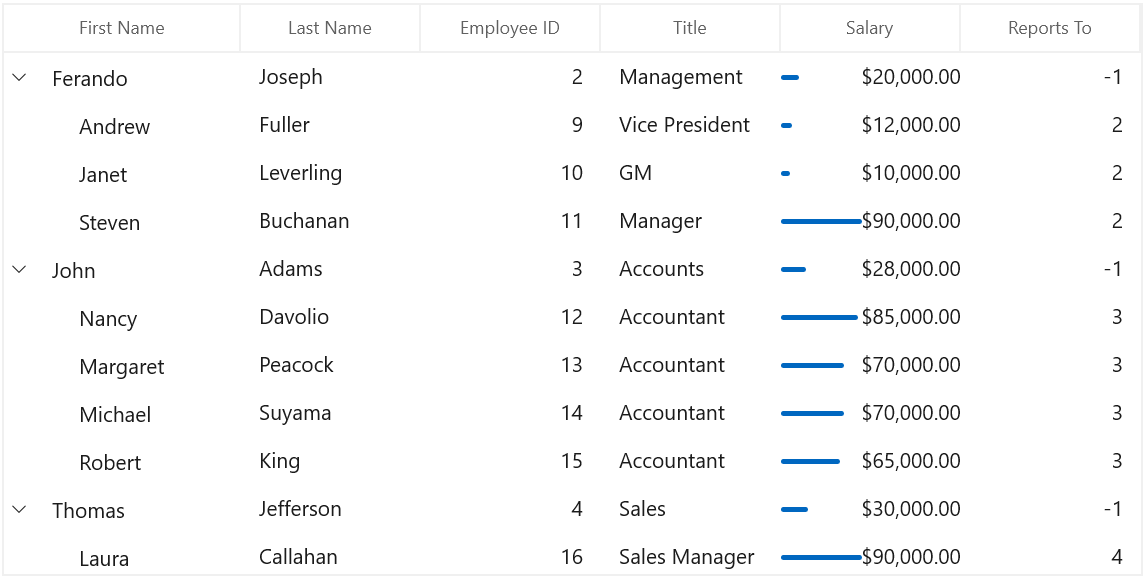
CellTemplate is not support by TreeGridHyperlinkColumn and TreeGridCheckboxColumn columns.
Reusing same DataTemplate for multiple columns
By default, underlying record is DataContext for CellTemplate. So you have to define, template for each column to display values based on MappingName.
You can use the same DataTemplate for all columns to display value based on MappingName by setting TreeGridColumn.SetCellBoundValue property to true. When SetCellBoundValue is set to true, the DataContext for CellTemplate is changed to DataContextHelper which has the following members,
-
Value- Return the value base onMappingName. -
Record- Returns the underlying data object.
<treeGrid:SfTreeGrid Name="treeGrid"
ColumnWidthMode="Star"
AutoExpandMode="AllNodesExpanded"
AutoGenerateColumns="False"
ChildPropertyName="ReportsTo"
ItemsSource="{Binding Employees}"
ParentPropertyName="ID"
SelfRelationRootValue="-1" >
<treeGrid:SfTreeGrid.Resources>
<DataTemplate x:Key="cellTemplate">
<TextBlock Margin="3,0,0,0"
Foreground="Red"
TextAlignment="Center"
Text="{Binding Path=Value}" />
</DataTemplate>
</treeGrid:SfTreeGrid.Resources>
<treeGrid:SfTreeGrid.Columns>
<treeGrid:TreeGridTextColumn CellTemplate="{StaticResource cellTemplate}"
HeaderText="First Name"
MappingName="FirstName"
SetCellBoundValue="True" />
<treeGrid:TreeGridTextColumn HeaderText="Last Name" MappingName="LastName" />
<treeGrid:TreeGridNumericColumn CellTemplate="{StaticResource cellTemplate}"
HeaderText="Employee ID"
MappingName="ID"
SetCellBoundValue="True" />
<treeGrid:TreeGridTextColumn MappingName="Title" />
<treeGrid:TreeGridNumericColumn MappingName="Salary" DisplayNumberFormat="C2"/>
<treeGrid:TreeGridNumericColumn HeaderText="Reports To" MappingName="ReportsTo" />
</treeGrid:SfTreeGrid.Columns>
</treeGrid:SfTreeGrid>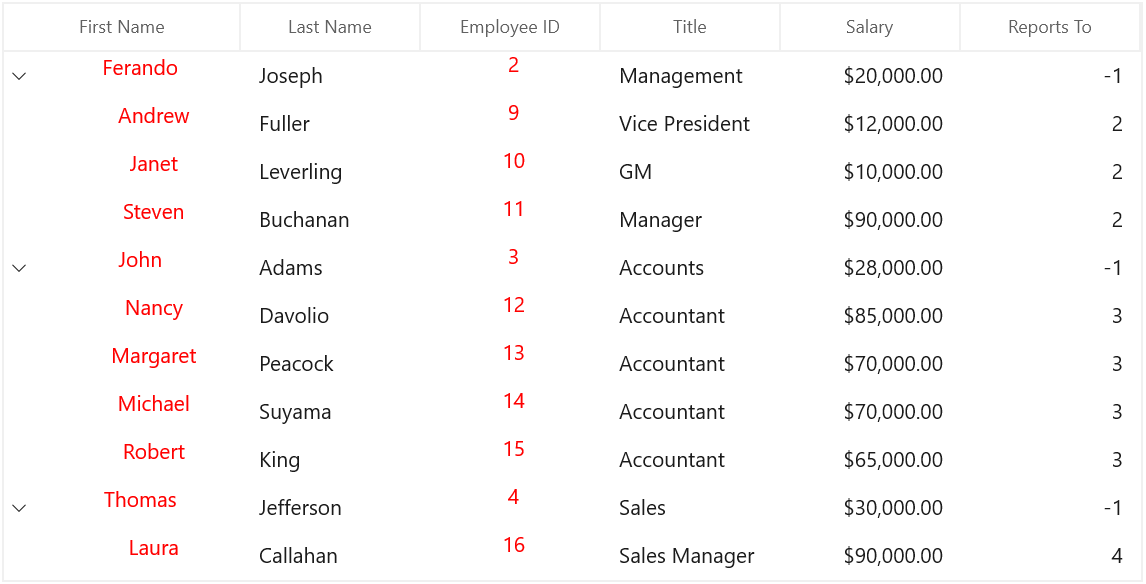
Setting CellTemplate based on custom logic using TemplateSelector
TreeGridColumn allows you to select a differentDataTemplate based on underlying data object by using the TreeGridColumn.CellTemplateSelector property.
For example, two different templates loaded alternatively in ID column.
<Application.Resources>
<local:CustomCellTemplateSelector x:Key="cellTemplateSelector" />
<DataTemplate x:Key="DefaultTemplate">
<TextBlock Foreground="Red"
Text="{Binding Path=ID}"
TextAlignment="Center" />
</DataTemplate>
<DataTemplate x:Key="AlternateTemplate">
<TextBlock Foreground="Green"
Text="{Binding Path=ID}"
TextAlignment="Center" />
</DataTemplate>
</Application.Resources>Below code returns the DefaultTemplate and AlternateTemplate based on Salary’s value.
public class CustomCellTemplateSelector : DataTemplateSelector
{
protected override DataTemplate SelectTemplateCore(object item, DependencyObject container)
{
if (item == null)
return null;
var data = item as EmployeeInfo;
if (data.ID < 10)
return App.Current.Resources["AlternateTemplate"] as DataTemplate;
else
return App.Current.Resources["DefaultTemplate"] as DataTemplate;
}
}In the below code, the custom template selector set to TreeGridColumn.CellTemplateSelector.
<treeGrid:SfTreeGrid Name="treeGrid"
ColumnWidthMode="Star"
AutoExpandMode="AllNodesExpanded"
AutoGenerateColumns="False"
ChildPropertyName="ReportsTo"
ItemsSource="{Binding Employees}"
ParentPropertyName="ID"
SelfRelationRootValue="-1" >
<treeGrid:SfTreeGrid.Columns>
<treeGrid:TreeGridTextColumn HeaderText="First Name" MappingName="FirstName" />
<treeGrid:TreeGridTextColumn HeaderText="Last Name" MappingName="LastName" />
<treeGrid:TreeGridNumericColumn CellTemplateSelector="{StaticResource cellTemplateSelector}"
HeaderText="Employee ID" MappingName="ID" />
<treeGrid:TreeGridTextColumn HeaderText="Title" MappingName="Title" />
<treeGrid:TreeGridNumericColumn MappingName="Salary" HeaderText="Salary" DisplayNumberFormat="C2"/>
<treeGrid:TreeGridNumericColumn HeaderText="Reports To" MappingName="ReportsTo" />
</treeGrid:SfTreeGrid.Columns>
</treeGrid:SfTreeGrid>NOTE
Non-Editable columns does not support
CellTemplate.
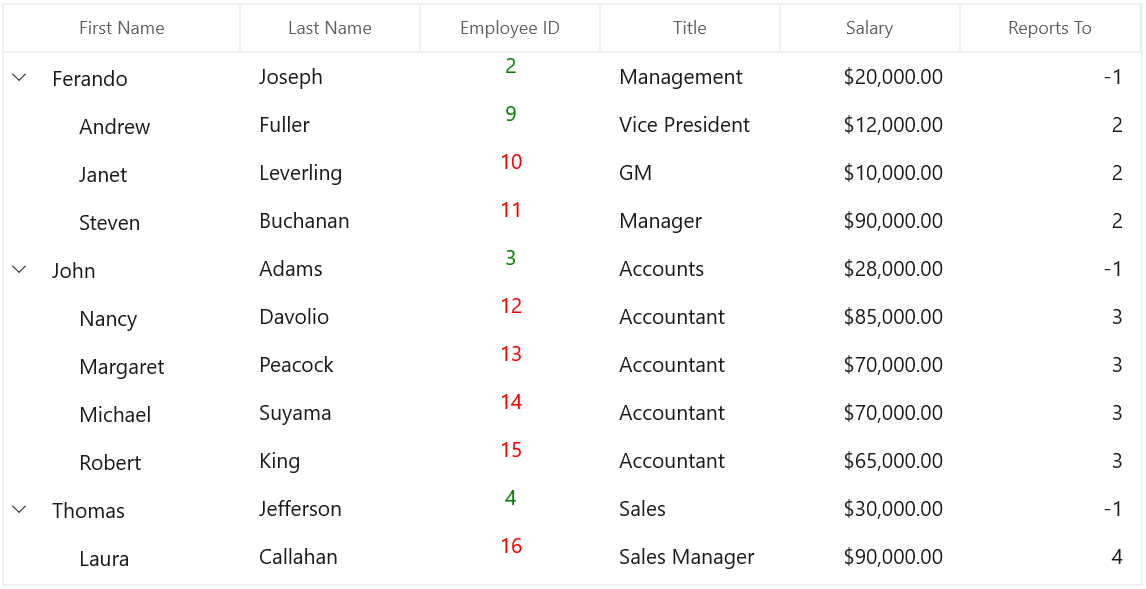
Data Formatting
TreeGridColumn supports to format the data using the Converter property, by defining the TreeGridColumn.DisplayBinding and TreeGridColumn.ValueBinding. In display mode TreeGridColumn.DisplayBinding formats the data. In edit mode, TreeGridColumn.ValueBinding formats the data.
Format column using Converter
You can format the column using Converter property by defining DisplayBinding.
<treeGrid:SfTreeGrid Name="treeGrid"
AutoExpandMode="AllNodesExpanded"
ChildPropertyName="ReportsTo"
ItemsSource="{Binding Employees}"
ParentPropertyName="ID">
<treeGrid:SfTreeGrid.Resources>
<local:CurrencyFormatConverter x:Key="converter" />
</treeGrid:SfTreeGrid.Resources>
<treeGrid:SfTreeGrid.Columns>
<treeGrid:TreeGridTextColumn HeaderText="Salary"
DisplayBinding="{Binding Salary,Converter={StaticResource converter}}"
MappingName="Salary" />
</treeGrid:SfTreeGrid.Columns>
</treeGrid:SfTreeGrid>public class CurrencyFormatConverter : IValueConverter
{
public object Convert(object value, Type targetType, object parameter, string language)
{
return string.Format("{0:C2}", value);
}
public object ConvertBack(object value, Type targetType, object parameter, string language)
{
return value;
}
}When column is auto-generated, you can set the Converter by handling AutoGeneratingColumn event
treeGrid.AutoGeneratingColumn += TreeGrid_AutoGeneratingColumn;
private void TreeGrid_AutoGeneratingColumn(object sender, TreeGridAutoGeneratingColumnEventArgs e)
{
if (e.Column.MappingName == "Salary")
{
if (e.Column is TreeGridTextColumn)
{
e.Column = new TreeGridTextColumn() { MappingName = "Salary" };
}
e.Column.DisplayBinding = new Binding() { Path = new PropertyPath(e.Column.MappingName), Converter = new CurrencyFormatConverter() };
}
}
Styling TreeGridColumn
TreeGridColumn support to customize the style of particular column using TreeGridColumn.CellStyle property.
Change the font setting
You can change the font settings such as FontSize, FontFamily, FontWeight etc. by writing style of TargetType TreeGridCell or TreeGridColumn.CellStyle property.
<treeGrid:SfTreeGrid Name="treeGrid"
ColumnWidthMode="Star"
AutoExpandMode="AllNodesExpanded"
AutoGenerateColumns="False"
ChildPropertyName="ReportsTo"
ItemsSource="{Binding Employees}"
ParentPropertyName="ID"
SelfRelationRootValue="-1" >
<treeGrid:SfTreeGrid.Columns>
<treeGrid:TreeGridTextColumn HeaderText="First Name" MappingName="FirstName" />
<treeGrid:TreeGridTextColumn HeaderText="Last Name" MappingName="LastName">
<treeGrid:TreeGridTextColumn.CellStyle>
<Style TargetType="treeGrid:TreeGridCell">
<Setter Property="FontSize" Value="12" />
<Setter Property="FontFamily" Value="Segoe UI" />
<Setter Property="FontWeight" Value="Bold" />
<Setter Property="FontStyle" Value="Italic" />
<Setter Property="FontStretch" Value="Condensed" />
</Style>
</treeGrid:TreeGridTextColumn.CellStyle>
</treeGrid:TreeGridTextColumn>
<treeGrid:TreeGridNumericColumn HeaderText="Employee ID" MappingName="ID" />
<treeGrid:TreeGridTextColumn HeaderText="Title" MappingName="Title" />
<treeGrid:TreeGridNumericColumn MappingName="Salary" HeaderText="Salary" DisplayNumberFormat="C2"/>
<treeGrid:TreeGridNumericColumn HeaderText="Reports To" MappingName="ReportsTo" />
</treeGrid:SfTreeGrid.Columns>
</treeGrid:SfTreeGrid>When column is auto-generated, you can style the column by handling AutoGeneratingColumn event
<Application.Resources>
<Style x:Key="cellStyle" TargetType="treeGrid:TreeGridCell">
<Setter Property="FontSize" Value="12" />
<Setter Property="FontFamily" Value="Segoe UI" />
<Setter Property="FontWeight" Value="Bold" />
<Setter Property="FontStyle" Value="Italic" />
<Setter Property="FontStretch" Value="Condensed" />
</Style>
</Application.Resources>treeGrid.AutoGeneratingColumn += TreeGrid_AutoGeneratingColumn;
private void TreeGrid_AutoGeneratingColumn(object sender, TreeGridAutoGeneratingColumnEventArgs e)
{
if (e.Column.MappingName == "FirstName")
{
e.Column.CellStyle=App.Current.Resources["cellStyle"] as Style;
}
}
Styles based on custom logic
You can apply the styles to columns based on certain condition using TreeGridColumn.CellStyleSelector property.
Below code creates two different styles by TargetType TreeGridCell.
<Application.Resources>
<Style x:Key="cellStyle1" TargetType="treeGrid:TreeGridCell">
<Setter Property="Background" Value="Bisque" />
</Style>
<Style x:Key="cellStyle2" TargetType="treeGrid:TreeGridCell">
<Setter Property="Background" Value="Aqua" />
</Style>
</Application.Resources>In the below code, returns the style based on ID value. Using Container you can format the columns data based on TreeGridCell.
public class CustomCellStyleSelector : StyleSelector
{
protected override Style SelectStyleCore(object item, DependencyObject container)
{
var treeGridCell = container as TreeGridCell;
var mappingName = treeGridCell.ColumnBase.TreeGridColumn.MappingName;
var record = treeGridCell.DataContext;
var cellValue = record.GetType().GetProperty(mappingName).GetValue(record);
if (mappingName.Equals("ID"))
{
if (Convert.ToInt16(cellValue)%3==0)
return App.Current.Resources["cellStyle1"] as Style;
else
return App.Current.Resources["cellStyle2"] as Style;
}
return base.SelectStyle(item, container);
}
}Below code, sets the customized style selector to TreeGridColumn.CellStyleSelector property.
<treeGrid:SfTreeGrid Name="treeGrid"
AutoExpandMode="AllNodesExpanded"
AutoGenerateColumns="True"
ChildPropertyName="ReportsTo"
ItemsSource="{Binding Employees}"
ParentPropertyName="ID">
<treeGrid:SfTreeGrid.Resources>
<local:CustomCellStyleSelector x:Key="cellStyleSelector" />
</treeGrid:SfTreeGrid.Resources>
<treeGrid:SfTreeGrid.Columns>
<treeGrid:TreeGridNumericColumn HeaderText="Employee ID" MappingName="ID"
CellStyleSelector="{StaticResource cellStyleSelector}" />
</treeGrid:SfTreeGrid.Columns>
</treeGrid:SfTreeGrid>When column is auto-generated, you can style the column by handling AutoGeneratingColumn event
treeGrid.AutoGeneratingColumn += TreeGrid_AutoGeneratingColumn;
private void TreeGrid_AutoGeneratingColumn(object sender, TreeGridAutoGeneratingColumnEventArgs e)
{
if (e.Column.MappingName == "ID")
{
e.Column.CellStyleSelector = new CustomCellStyleSelector();
}
}
UI Interaction
Hide Column
You can hide or unhide the particular column programmatically by setting TreeGridColumn.IsHidden property. For allowing end-user to hide or unhide column in UI refer Resizing Columns section.
Disable column
You can disable column by setting TreeGridColumn.AllowFocus property. Therefore, that column can’t be selected or edited.
Width, alignment and padding settings
Width
The width of TreeGridColumn can be changed by setting Width property. Column width set based on TreeGridColumn.MinimumWidth and TreeGridColumn.MaximumWidth properties.
NOTE
If the
TreeGridColumn.Widthis defined explicitly takes priority thanTreeGridColumn.ColumnSizer.
Padding
TreeGridColumn allows you to the change the padding of cell content by setting Padding property.
Alignment
TreeGridColumn allows you to change the alignment of TreeGridCell and TreeGridHeaderCellControl content using TextAlignment, VerticalAlignment and HorizontalHeaderContentAlignment properties.
TreeGridTextColumnBase
TreeGridTextColumnBase is the abstract class derived from TreeGridColumn. The following columns are derived from the TreeGridTextColumnBase.
-
TreeGridTextColumn
-
TreeGridNumericColumn
-
TreeGridDateColumn
-
TreeGridTimeColumn
-
TreeGridTemplateColumn
TreeGridTextColumnBase properties
-
Text trimming - You can trim the column’s data using the TextTrimming property.
-
Text wrapping - You can wrap the column’s data using the TextWrapping property.
<treeGrid:SfTreeGrid Name="treeGrid"
AutoExpandMode="AllNodesExpanded"
AutoGenerateColumns="True"
ChildPropertyName="ReportsTo"
ItemsSource="{Binding Employees}"
ParentPropertyName="ID">
<treeGrid:SfTreeGrid.Columns>
<treeGrid:TreeGridTextColumn HeaderText="Last Name"
MappingName="LastName"
Width="60"
TextTrimming="CharacterEllipsis"
TextWrapping="Wrap"/>
</treeGrid:SfTreeGrid.Columns>
</treeGrid:SfTreeGrid>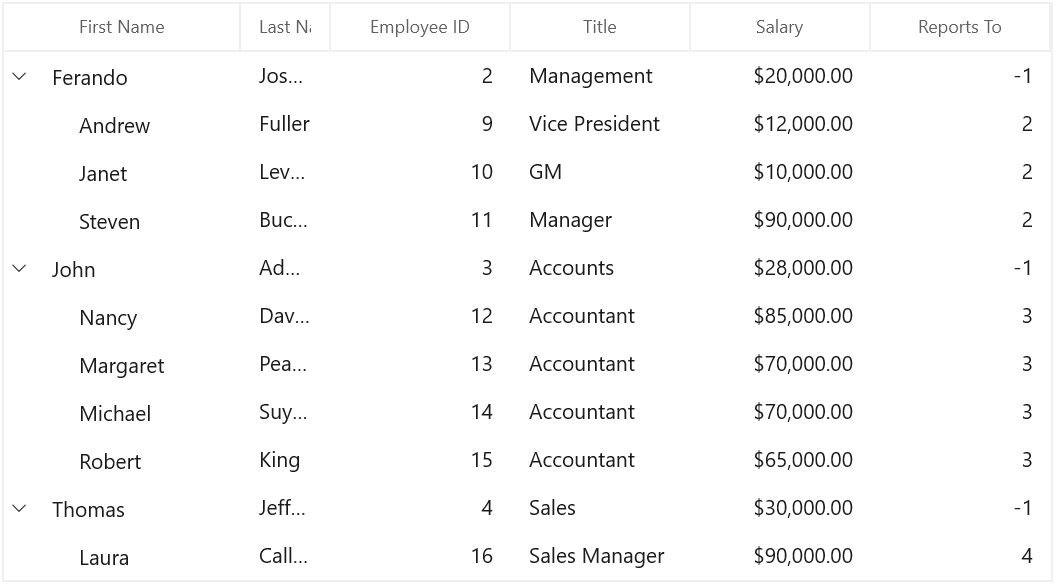
TreeGridTextColumn
TreeGridTextColumn derived from TreeGridTextColumnBase which hosts TextBox in edit mode.
<treeGrid:SfTreeGrid Name="treeGrid"
AutoGenerateColumns="False"
ChildPropertyName="ReportsTo"
ItemsSource="{Binding Employees}"
ParentPropertyName="ID">
<treeGrid:SfTreeGrid.Columns>
<treeGrid:TreeGridTextColumn HeaderText="First Name"
MappingName="FirstName"
/>
</treeGrid:SfTreeGrid.Columns>
</treeGrid:SfTreeGrid>treeGrid.Columns.Add(new TreeGridTextColumn()
{
MappingName = "FirstName",
HeaderText = "First Name"
});Spell check while editing
You can enable spell check in TreeGridTextColumn using IsSpellCheckEnabled property.
<treeGrid:TreeGridTextColumn HeaderText="First Name"
IsSpellCheckEnabled="True"
MappingName="FirstName" />this.treeGrid.Columns.Add(new TreeGridTextColumn() { MappingName = "FirstName", HeaderText = "First Name", IsSpellCheckEnabled = true });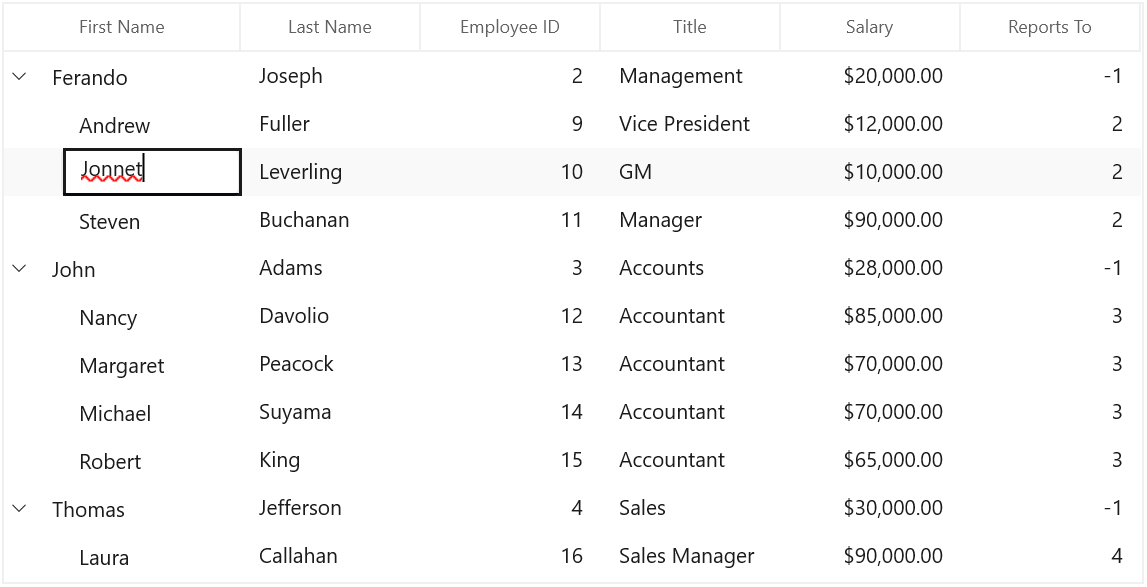
TreeGridNumericColumn
TreeGridNumericColumn is derived from TreeGridTextColumnBase and hosts NumberBox in edit mode.
<treeGrid:SfTreeGrid x:Name="treeGrid"
AutoExpandMode="RootNodesExpanded"
AutoGenerateColumns="False"
AllowEditing="True"
ItemsSource="{Binding EmployeeDetails}"
ChildPropertyName="ReportsTo"
ParentPropertyName="ID"
SelfRelationRootValue="-1" >
<treeGrid:SfTreeGrid.Columns>
<treeGrid:TreeGridTextColumn MappingName="FirstName" HeaderText="First Name" />
<treeGrid:TreeGridTextColumn MappingName="LastName" HeaderText="Last Name" />
<treeGrid:TreeGridNumericColumn HeaderText="Employee ID" MappingName="ID" />
<treeGrid:TreeGridTextColumn MappingName="Title" HeaderText="Title" />
<treeGrid:TreeGridNumericColumn MappingName="Salary" HeaderText="Salary" />
<treeGrid:TreeGridNumericColumn MappingName="ReportsTo" HeaderText="Reports To" />
</treeGrid:SfTreeGrid.Columns>
</treeGrid:SfTreeGrid>this.treeGrid.Columns.Add(new TreeGridNumericColumn()
{
HeaderText = "Salary",
MappingName = "Salary",
});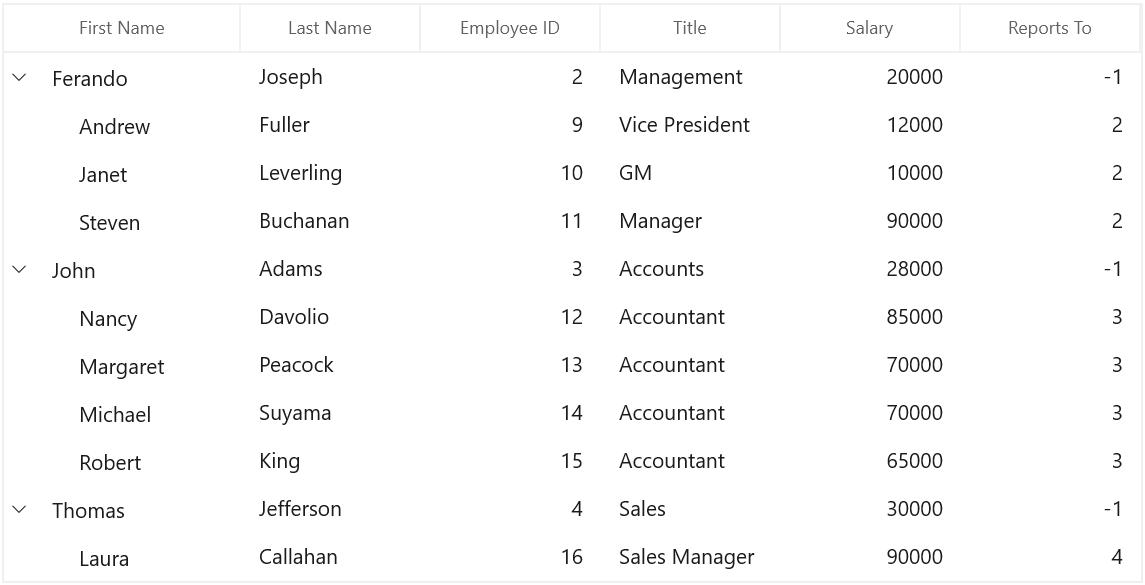
Change the format of numeric value
You can format the value of a TreeGridNumericColumn using the DisplayNumberFormat or NumberFormatter property. The default value of DisplayNumberFormat and NumberFormatter properties are null.
The following example shows how to set CurrencyFormatter for NumberFormatter property.
NOTE
To learn more about the formatting classes that can assigned for
NumberFormatterproperty. Refer here
CultureInfo culture = new CultureInfo("en-US");
// Format numericColumn in currency
numericColumn.NumberFormatter = new CurrencyFormatter(new RegionInfo(culture.LCID).ISOCurrencySymbol);You can also set the PercentFormatter and DecimalFormatter for NumberFormatter property to format the values in percent and numeric custom formats.
Using the N, C, and P format values, you can apply numeric, currency, and percent custom formats in DisplayNumberFormat property.
NOTE
When using both the
DisplayNumberFormatand theNumberFormatterproperties, theDisplayNumberFormatproperty takes high precedence.
<treeGrid:SfTreeGrid x:Name="treeGrid"
AutoExpandMode="RootNodesExpanded"
AutoGenerateColumns="False"
AllowEditing="True"
ItemsSource="{Binding EmployeeDetails}"
ChildPropertyName="ReportsTo"
ParentPropertyName="ID"
SelfRelationRootValue="-1" >
<treeGrid:SfTreeGrid.Columns>
<treeGrid:TreeGridTextColumn MappingName="FirstName" HeaderText="First Name" />
<treeGrid:TreeGridTextColumn MappingName="LastName" HeaderText="Last Name" />
<treeGrid:TreeGridNumericColumn HeaderText="Employee ID" MappingName="ID" />
<treeGrid:TreeGridTextColumn MappingName="Title" HeaderText="Title" />
<treeGrid:TreeGridNumericColumn MappingName="Salary" HeaderText="Salary" DisplayNumberFormat="C2" />
<treeGrid:TreeGridNumericColumn MappingName="ReportsTo" HeaderText="Reports To" />
</treeGrid:SfTreeGrid.Columns>
</treeGrid:SfTreeGrid>// Format numericColumn in currency
numericColumn.DisplayNumberFormat = "C2";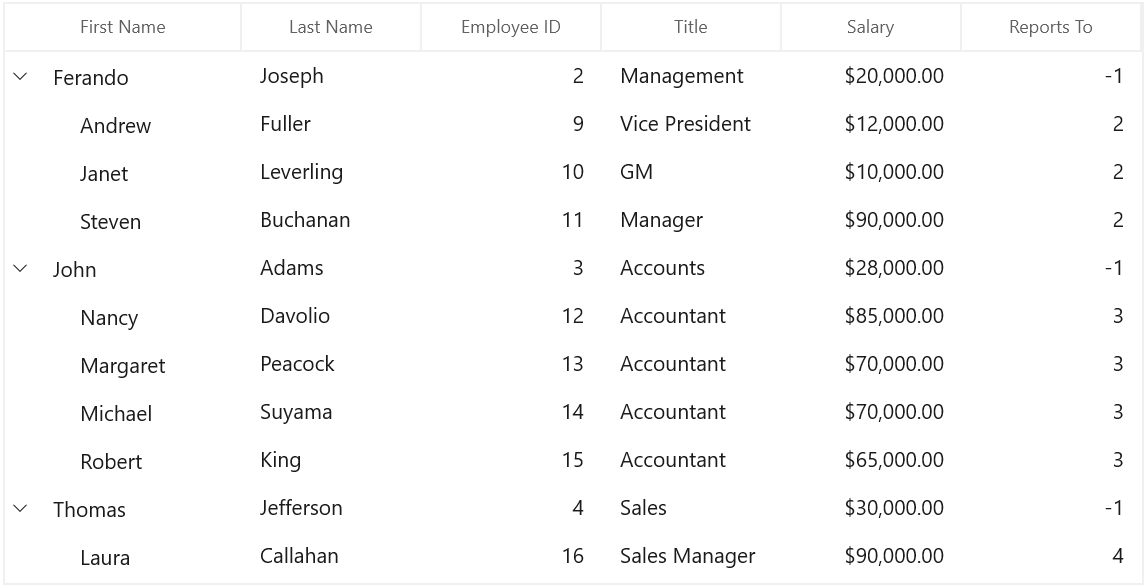
Null value support
TreeGridNumericColumn provides support to restrict or allow null value in columns based on AllowNull property. Instead of displaying null values, you can display hint text using the PlaceholderText property.
The PlaceholderText is not displayed, when the AllowNull is set to false.
<treeGrid:SfTreeGrid x:Name="treeGrid"
AutoExpandMode="RootNodesExpanded"
AutoGenerateColumns="False"
AllowEditing="True"
ItemsSource="{Binding EmployeeDetails}"
ChildPropertyName="ReportsTo"
ParentPropertyName="ID"
SelfRelationRootValue="-1" >
<treeGrid:SfTreeGrid.Columns>
<treeGrid:TreeGridTextColumn MappingName="FirstName" HeaderText="First Name" />
<treeGrid:TreeGridTextColumn MappingName="LastName" HeaderText="Last Name" />
<treeGrid:TreeGridNumericColumn HeaderText="Employee ID" MappingName="ID" />
<treeGrid:TreeGridTextColumn MappingName="Title" HeaderText="Title" />
<treeGrid:TreeGridNumericColumn MappingName="Salary" HeaderText="Salary" DisplayNumberFormat="C2"
AllowNull="True" PlaceholderText="Enter the amount" />
<treeGrid:TreeGridNumericColumn MappingName="ReportsTo" HeaderText="Reports To" />
</treeGrid:SfTreeGrid.Columns>
</treeGrid:SfTreeGrid>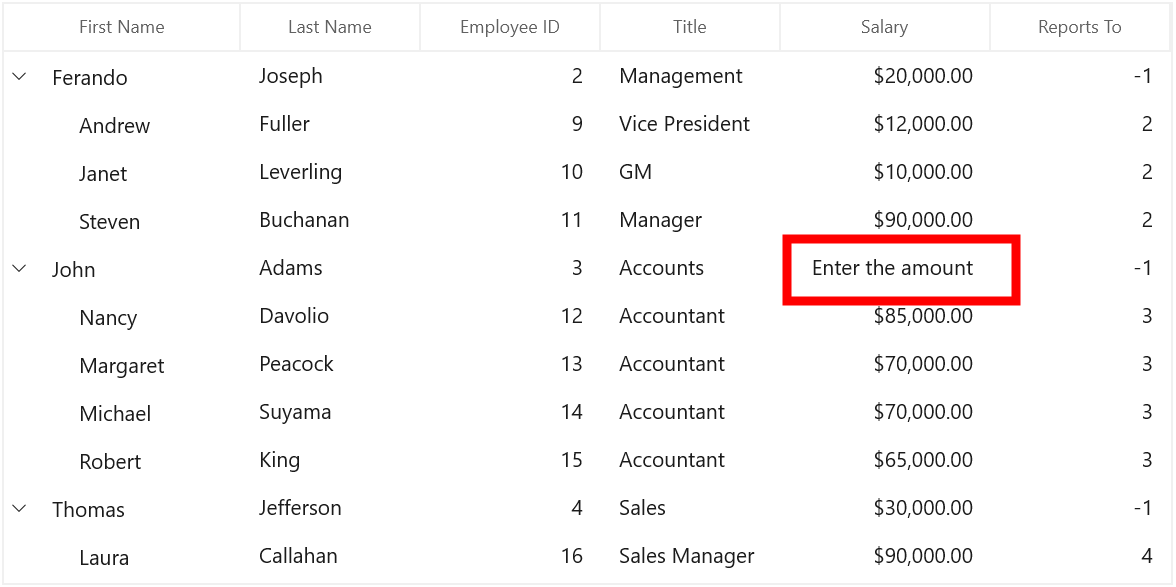
Restrict value within range
You can restrict the users to enter input within a minimum and maximum range in TreeGridNumericColumn using the MinValue and MaxValue properties. The default value of the MinValue property is double.MinValue and MaxValue property is double.MaxValue.
<treeGrid:SfTreeGrid x:Name="treeGrid"
AutoExpandMode="RootNodesExpanded"
AutoGenerateColumns="False"
AllowEditing="True"
ItemsSource="{Binding EmployeeDetails}"
ChildPropertyName="ReportsTo"
ParentPropertyName="ID"
SelfRelationRootValue="-1" >
<treeGrid:SfTreeGrid.Columns>
<treeGrid:TreeGridNumericColumn MappingName="Salary" HeaderText="Salary" MaxValue="100000" MinValue="5000" />
</treeGrid:SfTreeGrid.Columns>
</treeGrid:SfTreeGrid>Clear Button support
The TreeGridNumericColumn provides a clear button feature that enables users to reset cell values during editing using the ShowClearButton property.
When ShowClearButton is set to True, a clear button appears within the editor, providing users with a convenient way to clear the cell’s value.
AllowNull Behavior
The behavior of the clear button depends on the AllowNull property:
- When
AllowNullis toTrue, clicking the clear button sets the cell value tonull. - When
AllowNullis toFalse, clicking the clear button sets the cell value to the column’s
MinValue.
<treeGrid:SfTreeGrid Name="sfTreeGrid"
ChildPropertyName="ReportsTo"
ParentPropertyName="ID"
SelfRelationRootValue="-1"
AutoExpandMode="AllNodesExpanded"
ItemsSource="{Binding Employees}"
AllowEditing="True">
<treeGrid:SfTreeGrid.Columns>
<treeGrid:TreeGridNumericColumn HeaderText="Employee ID" MappingName="ID" ShowClearButton="True"/>
<treeGrid:TreeGridTextColumn HeaderText="First Name" MappingName="FirstName" />
<treeGrid:TreeGridTextColumn HeaderText="Last Name" MappingName="LastName" />
<treeGrid:TreeGridNumericColumn HeaderText="Salary" MappingName="Salary" />
<treeGrid:TreeGridNumericColumn HeaderText="Reports To" MappingName="ReportsTo" />
<treeGrid:TreeGridDateColumn HeaderText="Joining Date" MappingName="JoiningDate" Width="150"/>
</treeGrid:SfTreeGrid.Columns>
</treeGrid:SfTreeGrid>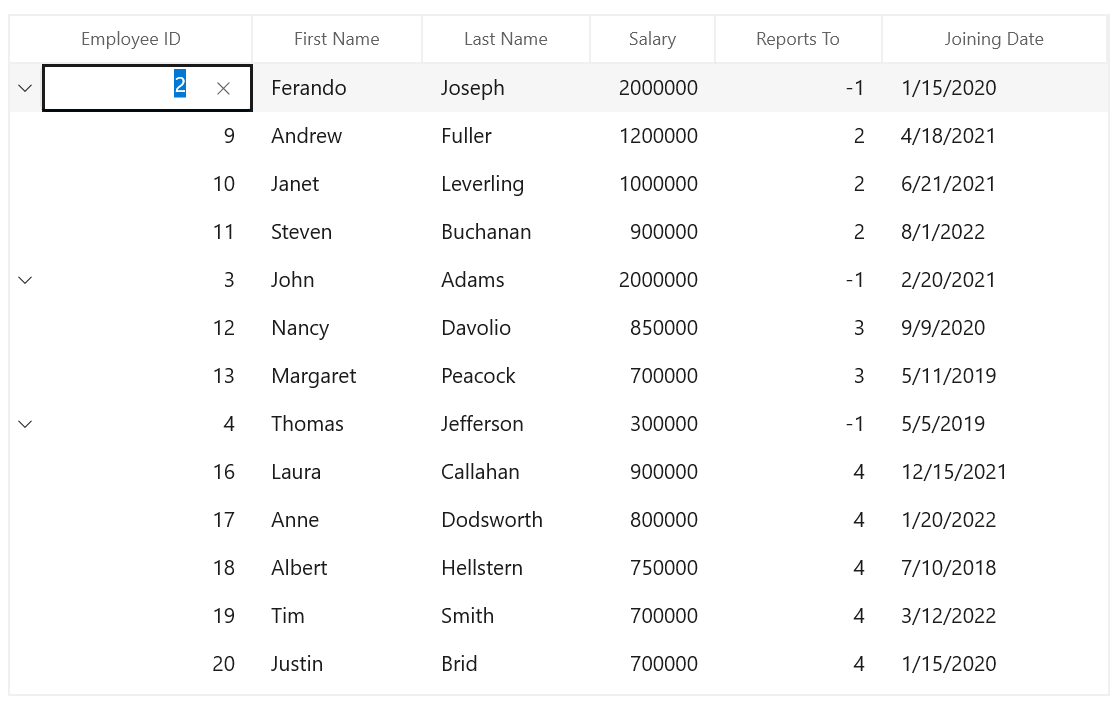
UpDown button placement
You can increase or decrease the value of the TreeGridNumericColumn using the up-down button. By default, the value of UpDownPlacementMode property is Hidden. You can change the up-down button position by assigning the value UpDownPlacementMode property as Inline or Compact.
<treeGrid:SfTreeGrid x:Name="treeGrid"
AutoExpandMode="RootNodesExpanded"
AutoGenerateColumns="False"
AllowEditing="True"
ItemsSource="{Binding EmployeeDetails}"
ChildPropertyName="ReportsTo"
ParentPropertyName="ID"
SelfRelationRootValue="-1" >
<treeGrid:SfTreeGrid.Columns>
<treeGrid:TreeGridNumericColumn MappingName="Salary" HeaderText="Salary" UpDownPlacementMode="InLine" />
</treeGrid:SfTreeGrid.Columns>
</treeGrid:SfTreeGrid>TreeGridDateColumn
TreeGridDateColumn is derived from TreeGridTextColumnBase and displays columns data as date. It hosts SfCalendarDatePicker element in editing mode.
<treeGrid:SfTreeGrid x:Name="treeGrid"
ChildPropertyName="ReportsTo"
AutoExpandMode="RootNodesExpanded"
ItemsSource="{Binding EmployeeDetails}"
ParentPropertyName="ID"
SelfRelationRootValue="-1"
AllowEditing="True"
AutoGenerateColumns="False">
<treeGrid:SfTreeGrid.Columns>
<treeGrid:TreeGridTextColumn MappingName="FirstName" HeaderText="First Name" />
<treeGrid:TreeGridTextColumn MappingName="LastName" HeaderText="Last Name" />
<treeGrid:TreeGridNumericColumn HeaderText="Employee ID" MappingName="ID" />
<treeGrid:TreeGridDateColumn MappingName="Date" HeaderText="Date" />
<treeGrid:TreeGridTextColumn MappingName="Title" HeaderText="Title" />
<treeGrid:TreeGridNumericColumn MappingName="ReportsTo" HeaderText="Reports To" />
</treeGrid:SfTreeGrid.Columns>
</treeGrid:SfTreeGrid>this.treeGrid.Columns.Add(new TreeGridDateColumn() { HeaderText = "Date", MappingName = "Date" });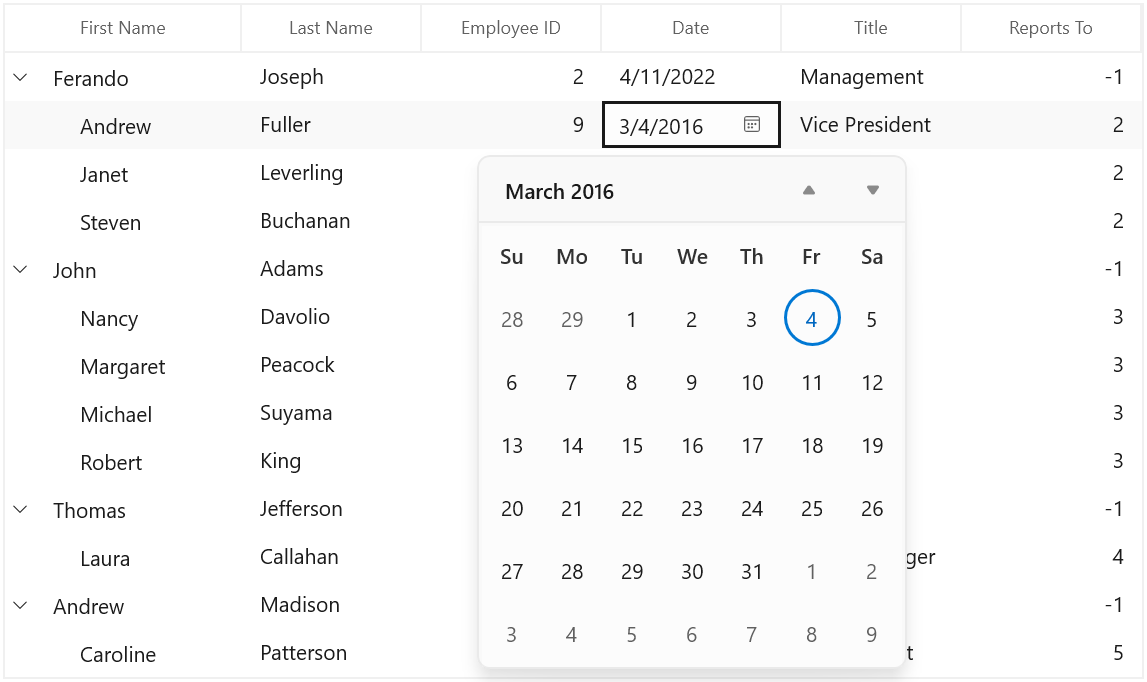
Change the format of date value
By using the DisplayDateFormat property, you can edit and display the selected date in various formats such as date, month and year formats. The default value of DisplayDateFormat property is d. For example, in the below image, the DateColumn has a DisplayDateFormat set to M.
<treeGrid:SfTreeGrid x:Name="treeGrid"
ChildPropertyName="ReportsTo"
AutoExpandMode="RootNodesExpanded"
ItemsSource="{Binding EmployeeDetails}"
ParentPropertyName="ID"
SelfRelationRootValue="-1"
AllowEditing="True"
AutoGenerateColumns="False">
<treeGrid:SfTreeGrid.Columns>
<treeGrid:TreeGridTextColumn MappingName="FirstName" HeaderText="First Name" />
<treeGrid:TreeGridTextColumn MappingName="LastName" HeaderText="Last Name" />
<treeGrid:TreeGridNumericColumn HeaderText="Employee ID" MappingName="ID" />
<treeGrid:TreeGridDateColumn MappingName="Date" HeaderText="Date" DisplayDateFormat="M" />
<treeGrid:TreeGridTextColumn MappingName="Title" HeaderText="Title" />
<treeGrid:TreeGridNumericColumn MappingName="ReportsTo" HeaderText="Reports To" />
</treeGrid:SfTreeGrid.Columns>
</treeGrid:SfTreeGrid>this.treeGrid.Columns.Add(new TreeGridDateColumn() { HeaderText = "Date", MappingName = "Date" , DisplayDateFormat="M" });
Null value support
TreeGridDateColumn provides support to restrict or allow null value in columns based on AllowNull property. Instead of displaying null values, you can display hint text using the PlaceholderText property.
The PlaceholderText is not displayed, when the AllowNull is set to false.
<treeGrid:SfTreeGrid x:Name="treeGrid"
ChildPropertyName="ReportsTo"
AutoExpandMode="RootNodesExpanded"
ItemsSource="{Binding EmployeeDetails}"
ParentPropertyName="ID"
SelfRelationRootValue="-1"
AllowEditing="True"
AutoGenerateColumns="False">
<treeGrid:SfTreeGrid.Columns>
<treeGrid:TreeGridTextColumn MappingName="FirstName" HeaderText="First Name" />
<treeGrid:TreeGridTextColumn MappingName="LastName" HeaderText="Last Name" />
<treeGrid:TreeGridNumericColumn HeaderText="Employee ID" MappingName="ID" />
<treeGrid:TreeGridDateColumn MappingName="Date" HeaderText="Date" AllowNull="True" PlaceholderText="Change the date" />
<treeGrid:TreeGridTextColumn MappingName="Title" HeaderText="Title" />
<treeGrid:TreeGridNumericColumn MappingName="ReportsTo" HeaderText="Reports To" />
</treeGrid:SfTreeGrid.Columns>
</treeGrid:SfTreeGrid>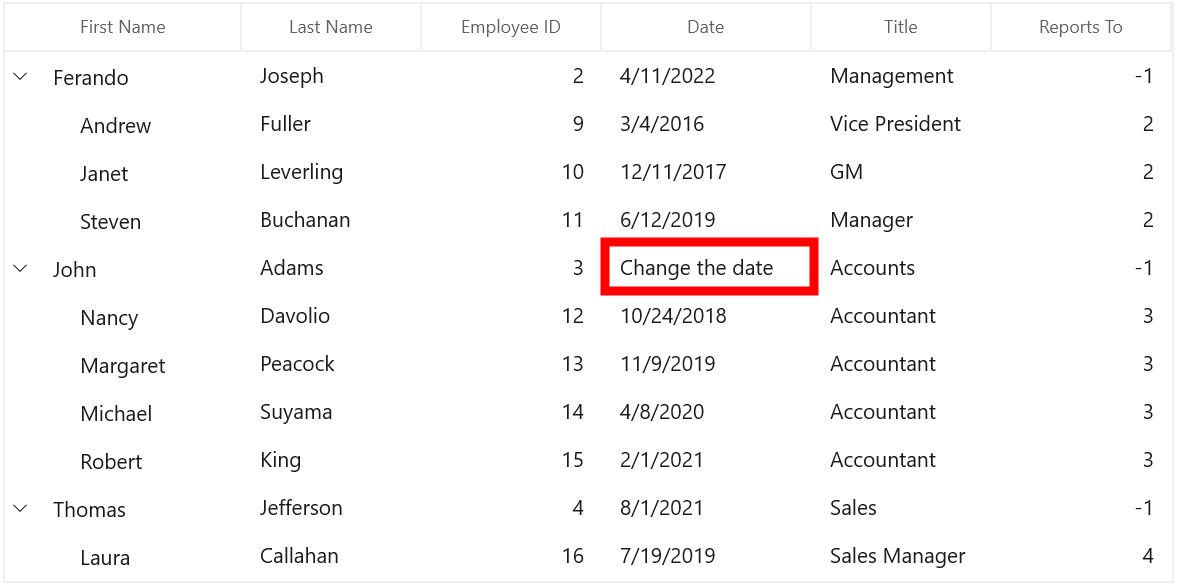
Setting date value range
You can restrict and display the input value within the range using the MinDate and MaxDate properties.
Clear Button support
The TreeGridDateColumn provides a clear button feature that enables users to reset cell values during editing using the ShowClearButton property.
When ShowClearButton is set to True, a clear button appears within the editor, providing users with a convenient way to clear the cell’s value.
AllowNull Behavior
The behavior of the clear button depends on the AllowNull property:
- When
AllowNullisTrue, clicking the clear button sets the cell value to null. - When
AllowNullisFalse, clicking the clear button sets the cell value to the column’s MinDate.
<treeGrid:SfTreeGrid Name="sfTreeGrid"
ChildPropertyName="ReportsTo"
ParentPropertyName="ID"
SelfRelationRootValue="-1"
AutoExpandMode="AllNodesExpanded"
ItemsSource="{Binding Employees}"
AllowEditing="True">
<treeGrid:SfTreeGrid.Columns>
<treeGrid:TreeGridNumericColumn HeaderText="Employee ID" MappingName="ID"/>
<treeGrid:TreeGridTextColumn HeaderText="First Name" MappingName="FirstName" />
<treeGrid:TreeGridTextColumn HeaderText="Last Name" MappingName="LastName" />
<treeGrid:TreeGridNumericColumn HeaderText="Salary" MappingName="Salary" />
<treeGrid:TreeGridNumericColumn HeaderText="Reports To" MappingName="ReportsTo" />
<treeGrid:TreeGridDateColumn HeaderText="Joining Date" MappingName="JoiningDate" Width="150" ShowClearButton="True"/>
</treeGrid:SfTreeGrid.Columns>
</treeGrid:SfTreeGrid>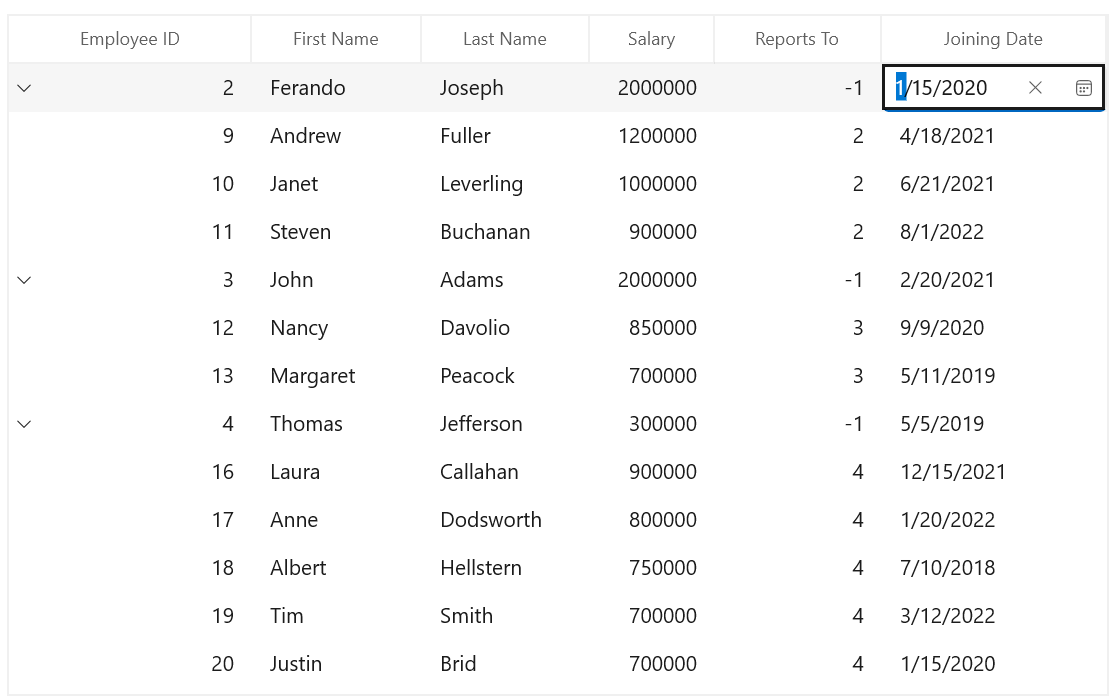
TreeGridTimeColumn
TreeGridTimeColumn is derived from TreeGridTextColumnBase and displays column data as time. In editing mode, it hosts the SfTimePicker element.
<treeGrid:SfTreeGrid Name="treeGrid"
ColumnWidthMode="Star"
AllowEditing="True"
AutoExpandMode="AllNodesExpanded"
AutoGenerateColumns="False"
ChildPropertyName="ReportsTo"
ItemsSource="{Binding Employees}"
ParentPropertyName="ID"
SelfRelationRootValue="-1" >
<treeGrid:SfTreeGrid.Columns>
<treeGrid:TreeGridTextColumn HeaderText="First Name" MappingName="FirstName"/>
<treeGrid:TreeGridTextColumn HeaderText="Last Name" MappingName="LastName" />
<treeGrid:TreeGridNumericColumn HeaderText="Employee ID" MappingName="ID" />
<treeGrid:TreeGridTimeColumn HeaderText="Reporting Time" MappingName="ReportingTime" />
<treeGrid:TreeGridTextColumn MappingName="Title" />
<treeGrid:TreeGridTextColumn HeaderText="Reports To" MappingName="ReportsTo" />
</treeGrid:SfTreeGrid.Columns>
</treeGrid:SfTreeGrid>treeGrid.Columns.Add(new TreeGridTimeColumn()
{
MappingName = "ReportingTime",
HeaderText = "Reporting Time"
});
Change the format of time value
By using the DisplayTimeFormat property, you can edit and display the selected time in various formats such as hour, minutes, seconds, meridiem, 12-Hour and 24-Hour format. The default value of DisplayTimeFormat property is hh:mm tt. For example, in the below image the TimeColumn has DisplayTimeFormat set to HH:mm tt.
<treeGrid:SfTreeGrid Name="treeGrid"
ColumnWidthMode="Star"
AllowEditing="True"
AutoExpandMode="AllNodesExpanded"
AutoGenerateColumns="False"
ChildPropertyName="ReportsTo"
ItemsSource="{Binding Employees}"
ParentPropertyName="ID"
SelfRelationRootValue="-1" >
<treeGrid:SfTreeGrid.Columns>
<treeGrid:TreeGridTextColumn HeaderText="First Name" MappingName="FirstName"/>
<treeGrid:TreeGridTextColumn HeaderText="Last Name" MappingName="LastName" />
<treeGrid:TreeGridNumericColumn HeaderText="Employee ID" MappingName="ID" />
<treeGrid:TreeGridTimeColumn HeaderText="Reporting Time" MappingName="ReportingTime" DisplayTimeFormat="HH:mm tt" />
<treeGrid:TreeGridTextColumn MappingName="Title" />
<treeGrid:TreeGridTextColumn HeaderText="Reports To" MappingName="ReportsTo" />
</treeGrid:SfTreeGrid.Columns>
</treeGrid:SfTreeGrid>treeGrid.Columns.Add(new TreeGridTimeColumn()
{
MappingName = "ReportingTime",
HeaderText = "Reporting Time"
DisplayTimeFormat="HH:mm tt",
});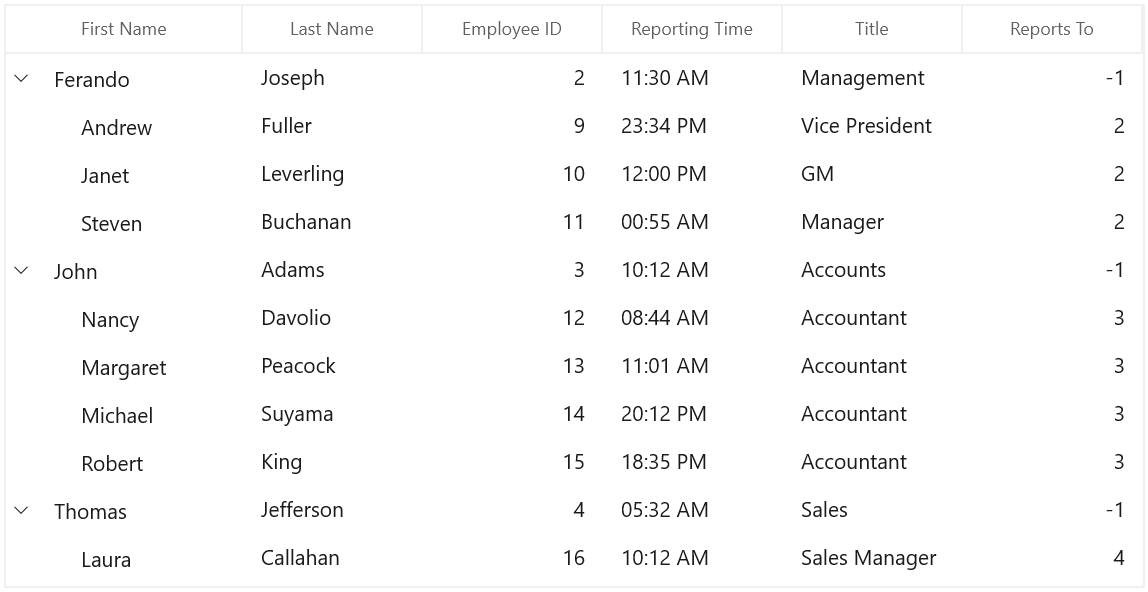
Null value support
TreeGridTimeColumn provides support to restrict or allow null value in columns based on AllowNull property. The default value of AllowNull property is True. Instead of displaying null values, you can display hint text using the PlaceholderText property.
The PlaceholderText is not displayed, when the AllowNull is set to false. The default value of PlaceholderText property is select a time.
<treeGrid:SfTreeGrid Name="treeGrid"
ColumnWidthMode="Star"
AllowEditing="True"
AutoExpandMode="AllNodesExpanded"
AutoGenerateColumns="False"
ChildPropertyName="ReportsTo"
ItemsSource="{Binding Employees}"
ParentPropertyName="ID"
SelfRelationRootValue="-1" >
<treeGrid:SfTreeGrid.Columns>
<treeGrid:TreeGridTextColumn HeaderText="First Name" MappingName="FirstName"/>
<treeGrid:TreeGridTextColumn HeaderText="Last Name" MappingName="LastName" />
<treeGrid:TreeGridNumericColumn HeaderText="Employee ID" MappingName="ID" />
<treeGrid:TreeGridTimeColumn HeaderText="Reporting Time" MappingName="ReportingTime" PlaceholderText="Change the time" />
<treeGrid:TreeGridTextColumn MappingName="Title" />
<treeGrid:TreeGridTextColumn HeaderText="Reports To" MappingName="ReportsTo" />
</treeGrid:SfTreeGrid.Columns>
</treeGrid:SfTreeGrid>treeGrid.Columns.Add(new TreeGridTimeColumn()
{
MappingName = "ReportingTime",
HeaderText = "Reporting Time"
PlaceholderText="Change the Time",
});
Setting time value range
You can restrict and display the input value within the range using the MinTime and MaxTime properties.
Editing support
TreeGridTimeColumn provides support to edit the time value in different modes.
Normal
To allow editing and perform input validation only after editing is completed, set the EditMode property value as Normal.
For more information refer here.
Mask
To allow editing and perform input validation as user edits the time value, set the EditMode property value as Mask.
The default value for EditMode property is Mask.
For more information refer here.
None
You can disable the editing in edit part by setting the EditMode Property as None.
Select time as you scroll spinner
If you want to hide the submit button and select the time directly from the drop-down time spinner without clicking Ok, set the ShowSubmitButtons property value as false. The default value of ShowSubmitButtons property is true.
<treeGrid:SfTreeGrid Name="treeGrid"
ColumnWidthMode="Star"
AllowEditing="True"
AutoExpandMode="AllNodesExpanded"
AutoGenerateColumns="False"
ChildPropertyName="ReportsTo"
ItemsSource="{Binding Employees}"
ParentPropertyName="ID"
SelfRelationRootValue="-1" >
<treeGrid:SfTreeGrid.Columns>
<treeGrid:TreeGridTextColumn HeaderText="First Name" MappingName="FirstName"/>
<treeGrid:TreeGridTextColumn HeaderText="Last Name" MappingName="LastName" />
<treeGrid:TreeGridNumericColumn HeaderText="Employee ID" MappingName="ID" />
<treeGrid:TreeGridTimeColumn HeaderText="Reporting Time" MappingName="ReportingTime" ShowSubmitButtons="False" />
<treeGrid:TreeGridTextColumn MappingName="Title" />
<treeGrid:TreeGridTextColumn HeaderText="Reports To" MappingName="ReportsTo" />
</treeGrid:SfTreeGrid.Columns>
</treeGrid:SfTreeGrid>treeGrid.Columns.Add(new TreeGridTimeColumn()
{
MappingName = "ReportingTime",
HeaderText = "Reporting Time"
ShowSubmitButtons="False",
});For more information refer here.
TreeGridCheckBoxColumn
TreeGridCheckBoxColumn derived from TreeGridColumn and it used display and edit Boolean type data. It hosts CheckBox element as TreeGridCell content.
<treeGrid:SfTreeGrid Name="treeGrid"
ColumnWidthMode="Star"
AllowEditing="True"
AutoExpandMode="AllNodesExpanded"
AutoGenerateColumns="False"
ChildPropertyName="ReportsTo"
ItemsSource="{Binding Employees}"
ParentPropertyName="ID"
SelfRelationRootValue="-1" >
<treeGrid:SfTreeGrid.Columns>
<treeGrid:TreeGridTextColumn HeaderText="First Name" MappingName="FirstName"/>
<treeGrid:TreeGridTextColumn HeaderText="Last Name" MappingName="LastName" />
<treeGrid:TreeGridNumericColumn HeaderText="Employee ID" MappingName="ID" />
<treeGrid:TreeGridTextColumn MappingName="Title" />
<treeGrid:TreeGridCheckBoxColumn HeaderText="Availability" MappingName="AvailabilityStatus" />
<treeGrid:TreeGridTextColumn HeaderText="Reports To" MappingName="ReportsTo" />
</treeGrid:SfTreeGrid.Columns>
</treeGrid:SfTreeGrid>treeGrid.Columns.Add(new TreeGridCheckBoxColumn()
{
MappingName = "AvailabilityStatus",
HeaderText = "Available Status"
});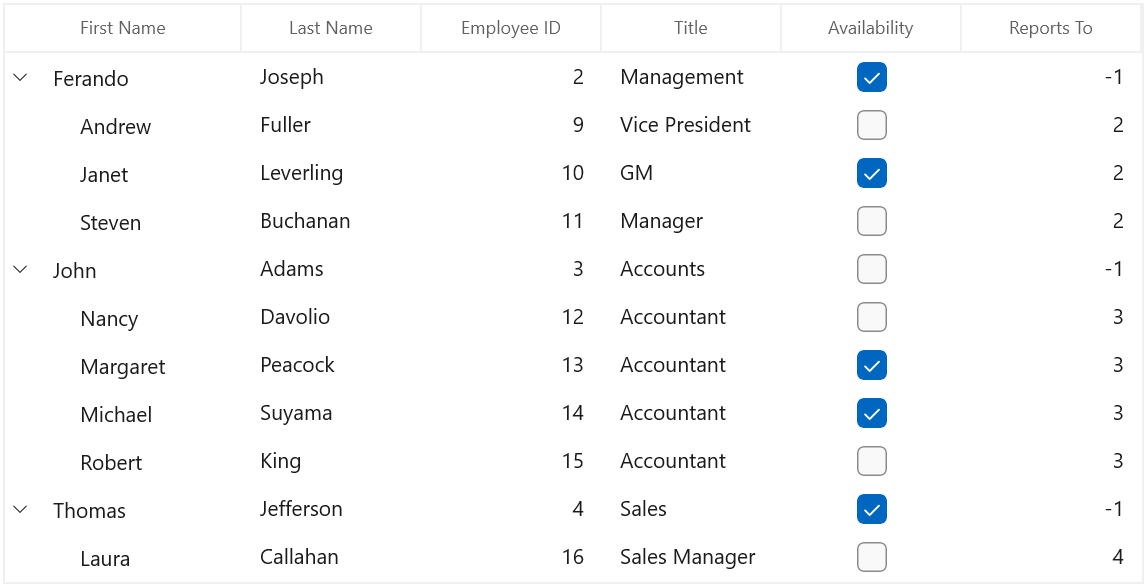
TreeGridCheckBoxColumn allows you to customize check box state and its alignment.
-
IsThreeState - By default, the
TreeGridCheckBoxColumnhasCheckedandUncheckedstate. You can enable anotherIntermediatestate settingIsThreeStateproperty totrue. -
HorizontalAlignment - You can change the horizontal alignment of CheckBox using
HorizontalAlignmentproperty.
TreeGridTemplateColumn
TreeGridTemplateColumn derived from TreeGridTextColumnBase and it displays the template-specified cell content. You can load any WinUI control in the display mode for all columns by setting CellTemplate and EditTemplate properties.
xmlns:treeGrid="using:Syncfusion.UI.Xaml.TreeGrid"
<treeGrid:SfTreeGrid Name="treeGrid"
ChildPropertyName="ReportsTo"
ItemsSource="{Binding Employees}"
ParentPropertyName="ID">
<treeGrid:SfTreeGrid.Columns>
<treeGrid:TreeGridTemplateColumn MappingName="FirstName" HeaderText="First Name">
<treeGrid:TreeGridTemplateColumn.CellTemplate>
<DataTemplate>
<TextBlock Text="{Binding FirstName}"/>
</DataTemplate>
</treeGrid:TreeGridTemplateColumn.CellTemplate>
<treeGrid:TreeGridTemplateColumn.EditTemplate>
<DataTemplate>
<TextBox Text="{Binding FirstName}" />
</DataTemplate>
</treeGrid:TreeGridTemplateColumn.EditTemplate>
</treeGrid:TreeGridTemplateColumn>
</treeGrid:SfTreeGrid.Columns>
</treeGrid:SfTreeGrid>StringBuilder sb1 = new StringBuilder();
sb1.Append("<DataTemplate xmlns=\"http://schemas.microsoft.com/winfx/2006/xaml/presentation\">");
sb1.Append("<TextBlock Text=\"{Binding FirstName}\" />");
sb1.Append("</DataTemplate>");
DataTemplate cellTemplate = (DataTemplate)XamlReader.Load(sb1.ToString());
StringBuilder sb2 = new StringBuilder();
sb2.Append("<DataTemplate xmlns=\"http://schemas.microsoft.com/winfx/2006/xaml/presentation\">");
sb2.Append("<TextBox Text=\"{Binding FirstName, Mode=TwoWay}\" />");
sb2.Append("</DataTemplate>");
DataTemplate editTemplate = (DataTemplate)XamlReader.Load(sb2.ToString());
this.treeGrid.Columns.Add(new TreeGridTemplateColumn()
{
MappingName = "FirstName",
CellTemplate = cellTemplate,
EditTemplate = editTemplate
});Sets EditTemplate based on custom logic
TreeGridTemplateColumn provides support to load different edit elements based on underlying data object using TreeGridTemplateColumn.EditTemplateSelector property.
Below code returns the DefaultTemplate and AlternateTemplate based on ID’s value.
<Application.Resources>
<DataTemplate x:Key="DefaultCellTemplate">
<TextBlock VerticalAlignment="Center"
Foreground="Red"
Text="{Binding Path=ID}"
TextAlignment="Center" />
</DataTemplate>
<DataTemplate x:Key="AlternateCellTemplate">
<TextBlock VerticalAlignment="Center"
Foreground="Green"
Text="{Binding Path=ID}"
TextAlignment="Center" />
</DataTemplate>
<DataTemplate x:Key="DefaultEditTemplate">
<TextBox Height="45"
VerticalAlignment="Center"
Foreground="Red"
Text="{Binding Path=ID}"
TextAlignment="Center" />
</DataTemplate>
<DataTemplate x:Key="AlternateEditTemplate">
<TextBox Height="45"
VerticalAlignment="Center"
Foreground="Green"
Text="{Binding Path=ID}"
TextAlignment="Center" />
</DataTemplate>
</Application.Resources>public class CustomCellTemplateSelector : DataTemplateSelector
{
protected override DataTemplate SelectTemplateCore(object item, DependencyObject container)
{
if (item == null)
return null;
var data = item as EmployeeInfo;
if (data.ID % 2 == 0)
return App.Current.Resources["AlternateCellTemplate"] as DataTemplate;
else
return App.Current.Resources["DefaultCellTemplate"] as DataTemplate;
}
}
public class CustomEditTemplateSelector : DataTemplateSelector
{
protected override DataTemplate SelectTemplateCore(object item, DependencyObject container)
{
if (item == null)
return null;
var data = item as EmployeeInfo;
if (data.ID % 2 == 0)
return App.Current.Resources["AlternateEditTemplate"] as DataTemplate;
else
return App.Current.Resources["DefaultEditTemplate"] as DataTemplate;
}
}In the below code, custom template selector set to TreeGridTemplateColumn.EditTemplateSelector.
<treeGrid:SfTreeGrid Name="treeGrid"
AllowEditing="True"
AutoExpandMode="RootNodesExpanded"
AutoGenerateColumns="False"
ChildPropertyName="ReportsTo"
ItemsSource="{Binding Employees}"
ParentPropertyName="ID">
<treeGrid:SfTreeGrid.Resources>
<local:CustomCellTemplateSelector x:Key="cellTemplateSelector" />
<local:CustomEditTemplateSelector x:Key="editTemplateSelector" />
</treeGrid:SfTreeGrid.Resources>
<treeGrid:SfTreeGrid.Columns>
<treeGrid:TreeGridTemplateColumn CellTemplateSelector="{StaticResource cellTemplateSelector}"
EditTemplateSelector="{StaticResource editTemplateSelector}" HeaderText="Employee ID" MappingName="ID" />
</treeGrid:SfTreeGrid.Columns>
</treeGrid:SfTreeGrid>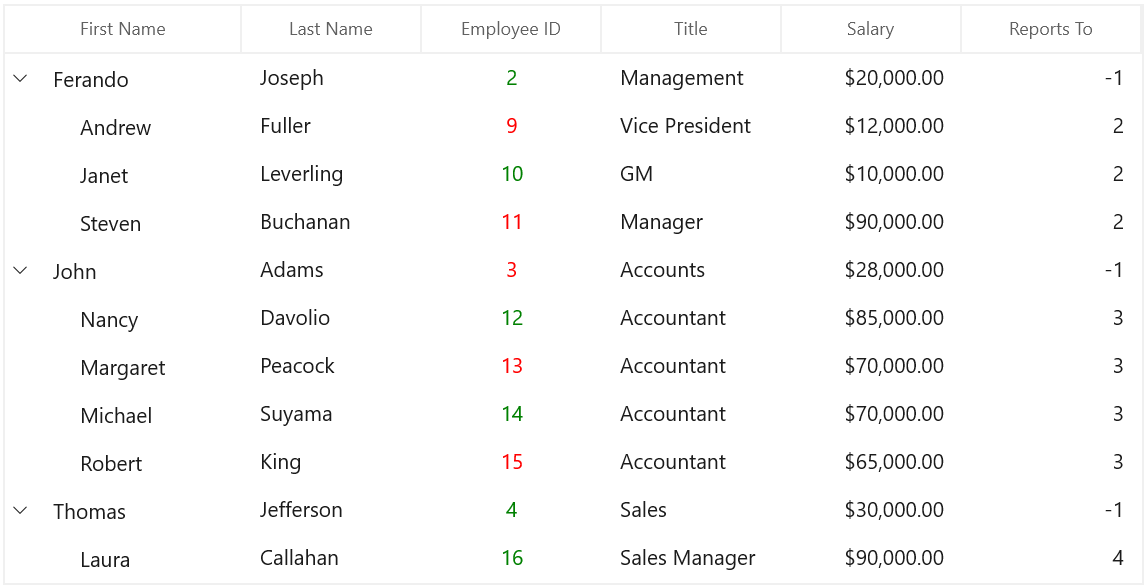
TreeGridComboBoxColumn
TreeGridComboBoxColumn derived from TreeGridColumn which hosts ComboBox as edit element. The data source to ComboBox can be set by using TreeGridComboBoxColumn.ItemsSource property.
By default, TreeGridComboBoxColumn displays the value using MappingName property. You can set DisplayMemberPath which denotes the path to a value on the source object (TreeGridComboBoxColumn.ItemsSource) to serve as the visual representation of object. You can set the SelectedValuePath which denotes the path to get the SelectedValue from the SelectedItem.
<treeGrid:SfTreeGrid x:Name="treeGrid"
AllowEditing="True"
AutoExpandMode="RootNodesExpanded"
AutoGenerateColumns="False"
ChildPropertyName="ReportsTo"
ItemsSource="{Binding Employees}"
ParentPropertyName="ID">
<treeGrid:SfTreeGrid.Columns>
<treeGrid:TreeGridComboBoxColumn ItemsSource="{Binding CityCollection, Source={StaticResource viewModel}}" MappingName="City" />
</treeGrid:SfTreeGrid.Columns>
</treeGrid:SfTreeGrid>treeGrid.Columns.Add(new TreeGridComboBoxColumn()
{
MappingName = "City",
ItemsSource = viewModel.CityCollection
});SfTreeGrid triggers, CurrentCellDropDownSelectionChanged event, when the SelectedValue is changed. CurrentCellDropDownSelectionChangedEventArgs of CurrentCellDropDownSelectionChanged event provides the information about the changed cell value.
SelectedIndex property returns the index of selected item.
SelectedItem property returns the selected item from drop down list.

Improving dropdown opening time
You can improve the drop-down opening time on loading by setting VirtualizingStackPanel as ItemsPanelTemplate of ComboBox, when the large number of items loaded in it.
<Application.Resources>
<Style TargetType="ComboBox">
<Setter Property="ItemsPanel">
<Setter.Value>
<ItemsPanelTemplate>
<VirtualizingStackPanel />
</ItemsPanelTemplate>
</Setter.Value>
</Setter>
</Style>
</Application.Resources>Opening dropdown popup in single-click
You can open the drop down within single click by setting ComboBox.IsDropDownOpen property to true in OnInitializeEditElementmethod by overriding existing renderer.
Below code, creates TreeGridCellComboBoxRendererExt to set IsDropDownOpen property. Replace the default renderer with created renderer in SfTreeGrid.CellRenderers collection.
treeGrid.CellRenderers.Remove("ComboBox");
treeGrid.CellRenderers.Add("ComboBox", new TreeGridCellComboBoxRendererExt());
public class TreeGridCellComboBoxRendererExt : TreeGridCellComboBoxRenderer
{
public override void OnInitializeEditElement(TreeDataColumnBase dataColumn, ComboBox uiElement, object dataContext)
{
base.OnInitializeEditElement(dataColumn, uiElement, dataContext);
uiElement.IsDropDownOpen = true;
}
}NOTE
This is applicable when
SfTreeGrid.EditTriggerisOnTap
TreeGridHyperlinkColumn
TreeGridHyperlinkColumn derived from TreeGridTextColumn and it displays columns data as hyperlink. It hosts HyperlinkButton element as TreeGridCell content.
<treeGrid:SfTreeGrid Name="treeGrid"
ColumnWidthMode="Star"
AllowEditing="True"
AutoExpandMode="AllNodesExpanded"
AutoGenerateColumns="False"
ChildPropertyName="ReportsTo"
ItemsSource="{Binding Employees}"
ParentPropertyName="ID"
SelfRelationRootValue="-1" >
<treeGrid:SfTreeGrid.Columns>
<treeGrid:TreeGridHyperlinkColumn HeaderText="Last Name" MappingName="LastName" />
</treeGrid:SfTreeGrid.Columns>
</treeGrid:SfTreeGrid>treeGrid.Columns.Add(new TreeGridHyperlinkColumn()
{
MappingName = "City",
HeaderText ="City"
});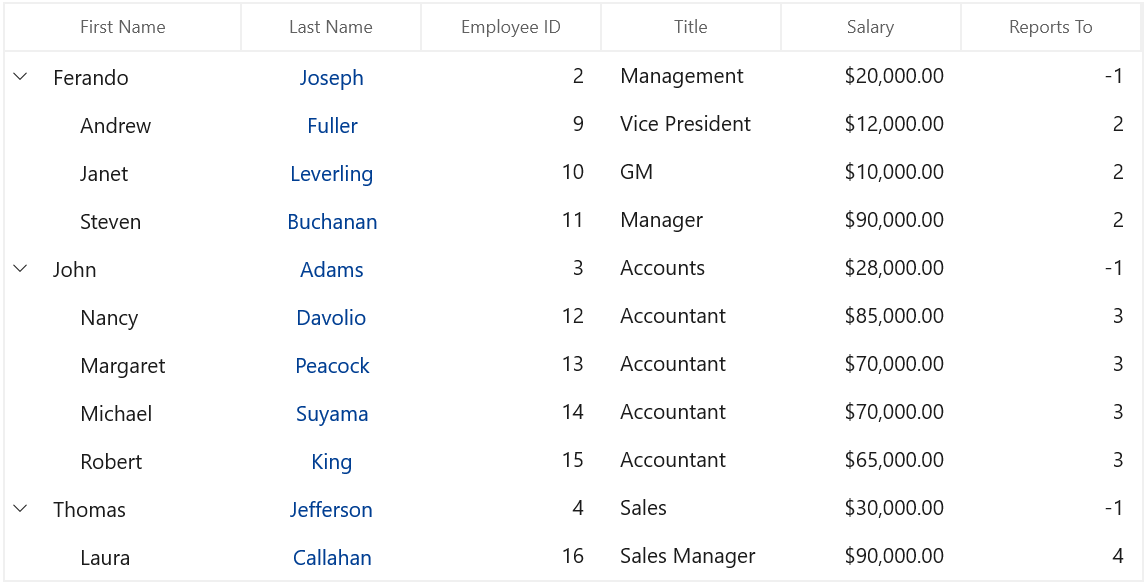
You can allow end-user to navigate the Uri when the cell value contains valid Uri address or using CurrentCellRequestNavigate event. The CurrentCellRequestNavigate occurs when the current cell in TreeGridHyperLinkColumn is clicked for navigation.
CurrentCellRequestNavigateEventArgs of CurrentCellRequestNavigate event provide information about the hyperlink triggered this event. CurrentCellRequestNavigateEventArgs.NavigateText returns the value using ValueBinding or MappingName to navigate.
treeGrid.CurrentCellRequestNavigate += TreeGrid_CurrentCellRequestNavigate;
private void TreeGrid_CurrentCellRequestNavigate(object sender, CurrentCellRequestNavigateEventArgs e)
{
var URI = string.Format("https://en.wikipedia.org/wiki/" + e.NavigateText);
Windows.System.Launcher.LaunchUriAsync(new Uri(URI));
}Cancel the navigation
You can cancel the navigation when clicking hyperlink by setting CurrentCellRequestNavigateEventArgs.Handled to false.
treeGrid.CurrentCellRequestNavigate += TreeGrid_CurrentCellRequestNavigate;
private async void TreeGrid_CurrentCellRequestNavigate(object sender, Syncfusion.UI.Xaml.Grid.CurrentCellRequestNavigateEventArgs args)
{
args.Handled = true;
}Customize Hyperlink
Change the alignment
You can change the horizontal alignment of TreeGridHyperlinkColumn using HorizontalAlignment property.
Change the foreground color
You can change the foreground color of TreeGridHyperlinkColumn by writing the style with target type HyperlinkButton.
<Application.Resources>
<Style TargetType="HyperlinkButton">
<Setter Property="Foreground" Value="Green" />
</Style>
</Application.Resources>
Customize column renderer
SfTreeGrid allows you to customize the column related operations like key navigation and UI related interactions by overriding the corresponding renderer associated with the column. Each column has its own renderer with set of virtual methods for handling the column level operations.
Below table lists the available cell types for unbound row and its renderers.
| Column Name | Renderer | Cell Type |
|---|---|---|
| TextBox | ||
| Numeric | ||
| DateTimeOffset | ||
| Time | ||
| CheckBox | ||
| Template | ||
| ComboBox | ||
| HyperlinkButton |
Below code, creates the TreeGridCellTextBoxRendererExt to change the fore ground of FirstName column and replacing created renderer to CellRenderers.
treeGrid.CellRenderers.Remove("TextBox");
treeGrid.CellRenderers.Add("TextBox",new TreeGridCellTextBoxRendererExt());
public class TreeGridCellTextBoxRendererExt : TreeGridCellTextBoxRenderer
{
public override void OnInitializeDisplayElement(TreeDataColumnBase dataColumn, TextBlock uiElement, object dataContext)
{
base.OnInitializeDisplayElement(dataColumn, uiElement, dataContext);
if (dataColumn.TreeGridColumn.MappingName.Equals("FirstName"))
uiElement.Foreground = new SolidColorBrush(Colors.Blue);
}
public override void OnUpdateDisplayBinding(TreeDataColumnBase dataColumn, TextBlock uiElement, object dataContext)
{
base.OnUpdateDisplayBinding(dataColumn, uiElement, dataContext);
if (dataColumn.TreeGridColumn.MappingName.Equals("FirstName"))
uiElement.Foreground = new SolidColorBrush(Colors.Blue);
}
}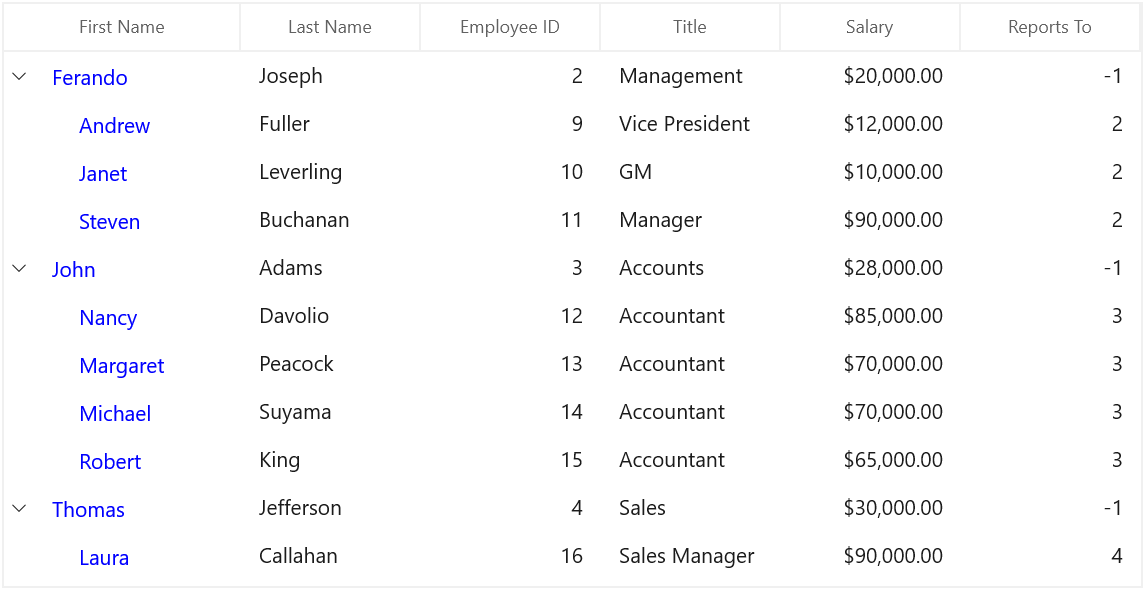
How To
Restrict the input content length
You can restrict the range of input using MaxLength property on TreeGridColumn in below ways.
-
Using Converter property in DisplayBinding and ValueBinding
-
Using control style
-
Overriding existing cell types
Using Converter
You can restrict the length of user input in both display and edit element using Converter using DisplayBinding and ValueBinding.
<treeGrid:SfTreeGrid x:Name="treeGrid"
AutoExpandMode="RootNodesExpanded"
AllowEditing="True"
AutoGenerateColumns="False"
ChildPropertyName="Children"
ItemsSource="{Binding EmployeeDetails}">
<treeGrid:SfTreeGrid.Resources>
<local:MaxLengthConverter x:Key="maxLengthConverter"/>
</treeGrid:SfTreeGrid.Resources>
<treeGrid:SfTreeGrid.Columns>
<treeGrid:TreeGridTextColumn HeaderText="First Name"
MappingName="FirstName"
DisplayBinding="{Binding FirstName,Converter={StaticResource maxLengthConverter}}"
ValueBinding="{Binding FirstName,Converter={StaticResource maxLengthConverter}}" />
</treeGrid:SfTreeGrid.Columns>
</treeGrid:SfTreeGrid>public class MaxLengthConverter : IValueConverter
{
public object Convert(object value, Type targetType, object parameter, string language)
{
// Define max length for column.
int maxLength = 5;
// Get the ColumnValue
var columnValue = System.Convert.ToString(value);
if (columnValue.Length < maxLength)
return columnValue;
else
return columnValue.Substring(0, maxLength);
}
public object ConvertBack(object value, Type targetType, object parameter, string language)
{
return value;
}
}Using control style
You can set the MaxLength property in edit mode by writing style of TargetType edit element of the corresponding column.
NOTE
TextBlock does not have the MaxLength property. Therefore, you can use the converter to format in display.
<treeGrid:SfTreeGrid x:Name="treeGrid"
AutoExpandMode="RootNodesExpanded"
AllowEditing="True"
AutoGenerateColumns="False"
ChildPropertyName="Children"
ItemsSource="{Binding EmployeeDetails}">
<treeGrid:SfTreeGrid.Resources>
<Style TargetType="TextBox">
<Setter Property="MaxLength" Value="7" />
</Style>
</treeGrid:SfTreeGrid.Resources>
<treeGrid:SfTreeGrid.Columns>
<treeGrid:TreeGridTextColumn HeaderText="First Name" MappingName="FirstName" />
</treeGrid:SfTreeGrid.Columns>
</treeGrid:SfTreeGrid>Overriding existing cell types
You can set the MaxLength property to the edit element of the particular column by overriding existing cell types.
Below code, overrides the OnInitializeEditElement method of the corresponding renderer and set the MaxLength to the UIElement and add the renderer to STreeGrid.CellRenderers collection.
treeGrid.CellRenderers.Remove("TextBox");
treeGrid.CellRenderers.Add("TextBox", new TreeGridCellTextBoxRendererExt());
public class TreeGridCellTextBoxRendererExt : TreeGridCellTextBoxRenderer
{
public override void OnInitializeEditElement(TreeDataColumnBase dataColumn, TextBox uiElement, object dataContext)
{
if (dataColumn.TreeGridColumn != null && dataColumn.TreeGridColumn.MappingName == "FirstName")
{
uiElement.MaxLength = 7;
}
else
{
uiElement.MaxLength = 0;
}
base.OnInitializeEditElement(dataColumn, uiElement, dataContext);
}
}